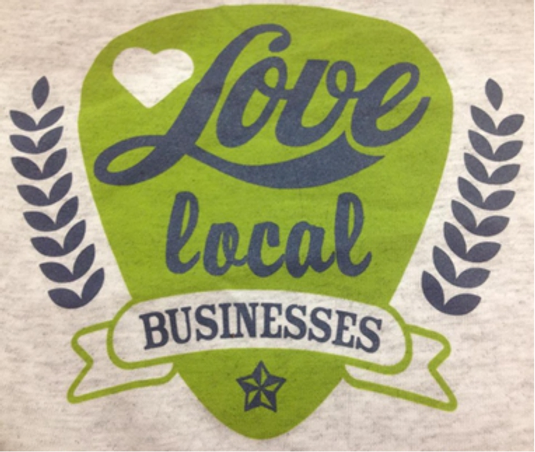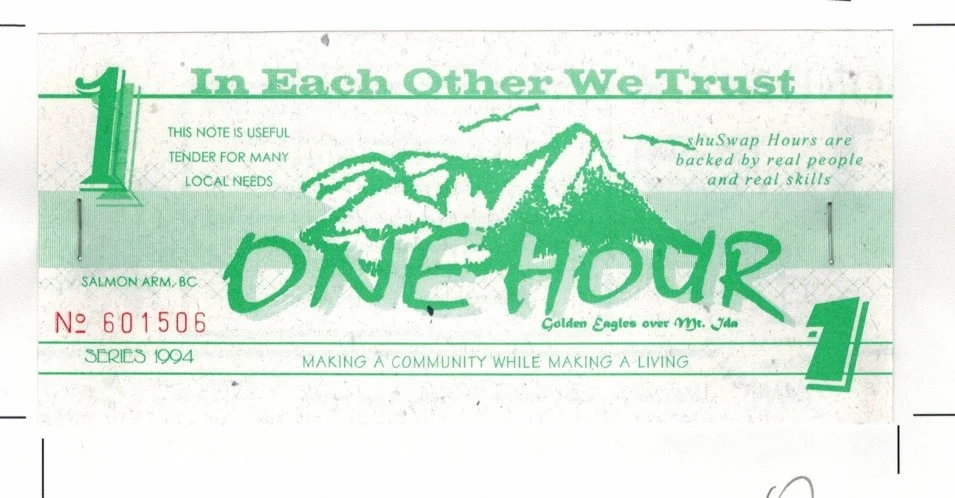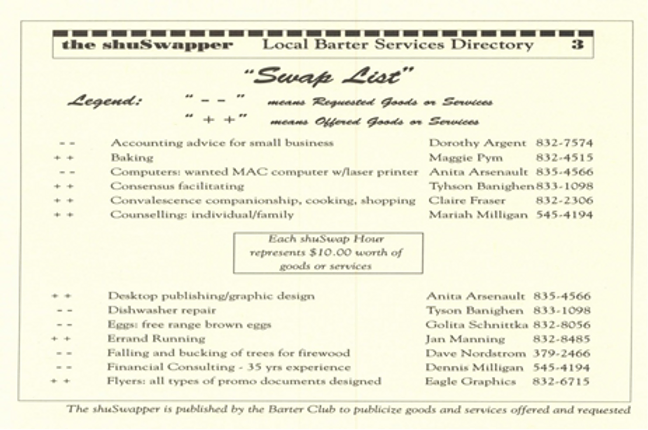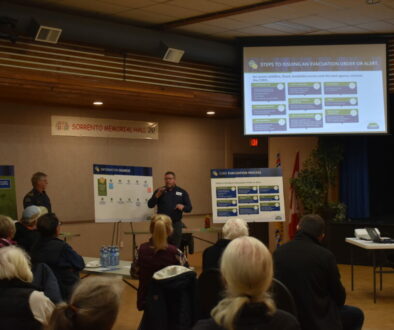The barter story
This is an original article from 1995 written by a local activist. Is the story about the Shuswap Barter Club which used its own currency back to 1994- 1996. Barter systems help create employment, stimulate local economies, and promote local skills and energy. By providing an alternative way to measure and trade skills, labor, and goods, barter systems present a challenge to the large-scale economic forces that can disrupt and destroy communities. Maybe we can be inspired by this story today to be more prepared for the challenges of the future.

Photo source: pinterest.com
People have been using ingenious methods to combat tough economic times for centuries. The “hungry thirties” of the great depression era are a vivid memory of hardship for many Canadians today. During the thirties, people printed “scrip” money as a way to facilitate exchanges of labor or goods when dollars were scarce. This idea has not been forgotten but has surfaced in our community as a way to create local jobs and bring people together.
The story of the Shuswap Barter Club begins with my own experience of hard times. In 1994, the job I had worked at for nine years was eliminated when the company was sold and restructured. For two days, I contemplated my future prospects.
The concept of a barter system had been in the back of my mind since reading an article in Mother Earth News (August/September, 1993). This article described how Ithaca, a small town in New York, had developed a local currency system to boost the town’s economy and morale. It intrigued me to see how a community could create a strategy that provided an alternative to our existing economic system and all its problems.
After two days, I decided to start a barter system and my first step was to see who else in the Shuswap was interested in the idea. I rented a hail and through an informal network of friends and acquaintances, called a public meeting on March 22, 1994 to test the idea. Forty people turned out!
Shortly after the public meeting, a dedicated dozen-and-a-half people met to develop the idea further. That evening, the Shuswap Barter Club was born. At the heart of the program is the principle of honoring everyone’s work equally. One hour of labor can be exchanged or bartered for another hour of labor. Two months after the founding meeting, we had developed our vision for the barter system and were ready to launch it in Salmon Arm. We decided to proceed with a local paper currency in order to make it as simple as possible to use. On May 22, 1994 we printed our first shuSwap Hours. The actual shuSwap Hour note is a piece of paper that is slightly larger than a Canadian dollar. Each Hour has been assigned a value of $10 and is used as a bartering tool to exchange goods or services with anyone else participating in the Shuswap Barter Club.
As new members join, they are issued four shuSwap Hour notes which they can begin exchanging immediately. To publicize the exchanges available, we produce the shuSwapper, a barter services directory listing both available and requested services and products. The number of Hours in circulation depends upon the number of members in the Barter Club. We also printed the currency in smaller denominations: one-half hour, one-quarter hour, and most recently, one-tenth hour. This has allowed more people to participate, including children. It also helps merchants who are part of the system to make change for smaller items.
“We are making a community while we are making a living”
The real strength of a local currency system comes from the fact that it is created locally and is therefore controlled locally. We choose the activities we support. Currently, all Canadian dollars coming into the Shuswap eventually leave again. We know that many find their way into the hands of large multinational corporations that are engaged in business practices that we do not always support.
The shuSwap Hour can only be used locally so it helps keep more local people’s energy and talents here, where they are needed most. The barter system promotes and reinforces our own local economy. After one year of existence, there are 600 shuSwap Hours in circulation in our community. This means that the equivalent of $6000 has been added to our local economy and it will be used over and over again. The more this system is used the more value it has and the greater benefit to the community. Every time a shuSwap Hour is spent, someone in the Shuswap is put to work. This is a powerful concept! The more members of the community that participate, the stronger the system and the healthier the community.
Community-building tool
We believe the Barter Club is a tool for community-building and self-empowerment. By taking positive action we hope to combat the growing unemployment this area is experiencing. The Barter Club is doing this by promoting local job creation and at the same time fostering a climate of optimism and co-operation.
The Shuswap Barter Club is a nonprofit organization supported entirely by its members and $20 annual membership dues. All members have an equal voice in decisions. For the past year, we have been meeting monthly at Barter Potlucks to make club decisions and provide a place for barter members to meet and exchange ideas as well as goods and services. The meetings are open to the public so that new individuals can meet other barter folk. Our members come from all walks of life: unemployed to professionals, home-based entrepreneurs to store-front merchants, young to retired.
Recently, we decided to add a monthly business meeting to the schedule so the Potlucks can be an informal time for networking, exchanges and community-building. One of our meetings was devoted to the developing a mission statement to reflect the expanding mandate of the Shuswap Barter Club including the changing of the name to Shuswap Barter Network.

Our mission statement reads:
The mission of the Shuswap Barter Network is to maintain an alternative economic system that uses a local currency for the fair exchange of goods and services, to provide networking opportunities which honour the dignity of the individual, and to foster a co-operative community spirit of caring and sharing.
The Barter Network has also considered the possibility of making grants or interest-free loans to support worthwhile projects or organizations that promote sound community values. For example, the Network could approve a grant to the local food bank to build shelves. The grant would be issued in shuSwap Hours, enabling the food bank to hire a local carpenter. These Hours would then circulate in the community putting additional people to work. Local control means that we, as community members, can choose the activities we want to support.


First year struggles and achievements
The first year of the Barter Network has seen the system grow from 18 founding members to over 135 active participants. My severance pay was the seed money that got us started and now the Barter Network is self-sustaining from membership dues. We would like the membership to double by next year.
Promoting the Barter Network is an important activity that has required a lot of volunteer hours. We have been busy making presentations about the potential of the shuSwap Hour to the Rotary Network, Chamber of Commerce, and other community organizations, including high school classroom instruction. We have taken advantage of free radio ads to get the message out. In a series of presentations and discussions, high school business education students learned about the Barter Network and the alternative it offers. Promoting the shuSwap Hour is important because the barter system needs to reach a “critical mass”. There needs to be enough variety in the services offered to keep the exchanges flowing. We also want local business people to be involved so that the barter system is visible in the community. We don’t want the Barter Network to be seen as an underground system that is a tax dodge. We want the shuSwap Hour to have a high profile in the community and be used alongside the Canadian dollar. We still need to attract more businesses into the Barter Network but we are slowly building a committed membership. Even the Mayor has joined!
The Barter Network has also been actively responding to interest from communities and organizations outside of the Shuswap. Calls for assistance have come from all over Canada and the United States. We send out information packets at least once a week and our Network has been featured in newspapers, magazines and radio interviews. The BC quarterly SPARC News profiled the Barter Network and we have been asked to present ideas on local community economics at the first annual Community Development Institute to be held at Okanagan College in Salmon Arm in August, 1995. WomenFutures, a nonprofit organization which operates a loan guarantee fund for women-operated initiatives in BC, has included the Shuswap Barter Network in its kit on alternative financing, Women Get Credit.
The Shuswap Barter Network is now one of three dozen barter systems in North America. Barter systems have recently been launched in Nelson (Kootenay Hour) and Halifax (Maritime Hour). Many people recognize the potential of the local currency idea and there should be more resources for supporting new barter systems.
The reverberations of the global economic melt-down in 2008 have sparked increased discussion concerning the stability of the “fiat” money system controlled by the IMF, World Bank, the FED, etc. Is this an idea whose time has come again? Let us know your thoughts.
(*) this article appeared in a Community Economic Development in British Columbia publication called “Sharing Stories” 1995. Published under the direction of Bill Barlee, Minister of Small Business, Tourism and Culture.
– EH, DB



